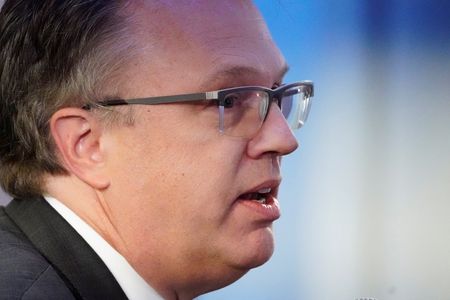By Michael S. Derby
NEW YORK (Reuters) -New York Federal Reserve President John Williams said on Tuesday inflation remains too high, which could open the door for the U.S. central bank to take a more aggressive path on interest rate increases.
Over the last year the U.S. central bank “has taken strong actions to bring inflation down,” Williams said in a speech delivered to a bankers’ group in New York. But, “although we have seen some moderation in recent months, the inflation rate remains far too high at 5%,” and underlying rates of inflation are also too high, he said.
“We must restore balance to the economy and bring inflation down to 2% on a sustained basis,” Williams said. “Our work is not yet done,” he said, adding that “we will we stay the course until our job is done.”
Referring to central bank forecasts from December showing the Fed’s benchmark overnight interest rate ending 2023 between 5.00% and 5.50%, Williams told reporters “that, to me right now, seems to be the right kind of framing” for the policy outlook.
Williams, who is vice chair of the rate-setting Federal Open Market Committee, spoke in the wake of Consumer Price Index data which showed the annualized pace of price pressures moderating slightly in January, but nevertheless coming in higher than the forecast in a Reuters poll of economists.
The CPI report keeps alive the prospect of more Fed rate rises as the central bank continues its effort to lower inflation back to its 2% target. The Fed raised its target rate by a quarter of a percentage point to the 4.50%-4.75% range at the start of this month, and will likely raise it further this year to somewhere north of 5.00%.
Williams’ comments were a touch more hawkish on the outlook for rates compared to his most recent public appearance, when he said a federal funds rate this year of between 5.00% and 5.25% “seems a very reasonable view” of what’s likely to happen on the monetary policy front.
On Tuesday, Williams said recent data has been stronger than expected and upside risks to future inflation levels could alter the longer-run policy outlook.
“With the strength in the labor market, clearly there are risks that inflation stays higher for longer than expected, or that we might need to raise rates higher” that current forecasts hold, Williams told reporters after his formal remarks.
He said it still remains key that the Fed get rates into restrictive territory before lowering them again to reflect falling inflation, a path that could allow for possible rate cuts in 2024 or 2025.
‘SUBDUED GROWTH’
In his speech, Williams warned that the path the central bank must pursue “will likely entail a period of subdued growth and some softening of labor market conditions.”
Williams said he believes core price pressures as measured by the core personal consumption expenditures price index could fall to 3% this year and to 2% over the next few years. The current core PCE reading, which is stripped of food and energy costs, stood at a year-over-year gain of 4.4% in December.
Williams also said in his remarks that growth will likely come in at a tepid 1% this year. What is currently a 3.4% jobless rate will likely rise to between 4% and 4.5%, he said. He added that the job market is currently “extremely tight” and wage gains are elevated.
(Reporting by Michael S. Derby; Editing by Andrea Ricci and Paul Simao)

